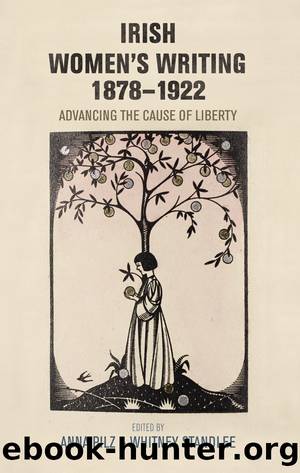Irish women's writing, 1878â1922 by Anna Pilz Whitney Standlee

Author:Anna Pilz, Whitney Standlee [Anna Pilz, Whitney Standlee]
Language: eng
Format: epub
ISBN: 9781526127112
Barnesnoble:
Publisher: Manchester University Press
Published: 2018-03-07T00:00:00+00:00
An âintricate network of social lifeâ is indeed revealed by the preceding ethnographic study in an essay that offers to demonstrate and elucidate to its readers an Irish âproblemâ beyond the ken of the occasional tourist; yet the closing judgements also serve to consolidate a narrative distance occupied by the amused but ultimately censorious (monoglot) observers.
Somerville and Rossâs 1910 essay âThe Anglo-Irish Languageâ, based on a review of Patrick Weston Joyceâs English as We Speak It in Ireland, provides their most extensive commentary on the subject of English in Ireland. The essay opens with the identification of Irelandâs complex linguistic history:
It would be as easy to coax the stars out of the sky into your hat as to catch the heart of a language and put it in a phrase-book. Ireland has two languages; one of them is her own by birthright; the second of them is believed to be English, which is a fallacy; it is a fabric built by Irish architects with English bricks, quite unlike anything of English construction.26
This theory of language evolution underlines the mobility of linguistic transfer and its ability to cross (at least some) class boundaries:
Gentlemen and peasants began to speak the same language, borrowing one from the other; the talk of the men of quality, bred in the classic tradition, enriched the vocabulary of the peasants, while the country gentlemen, themselves Irish speakers, absorbed into their English speech, something of the vigour and passion, the profuse imagery and wilful exaggeration that are inherent in the Gael.27
Contrastingly, the authors also recognise clearly the Anglicising force of upward social mobility: âHis [Joyceâs] harvest is reaped, as is but natural, among the peasants and the poor people of the towns; each upward step in the social scale is a step further from the Irish language and its enormous influences.â28
Nicole Pepinster Greeneâs fine essay on âDialect and Social Identity in The Real Charlotteâ reveals how, by âmanipulating their knowledge of social and regional Hiberno-English dialectsâ, Somerville and Ross âdelineate subtle differences of class and personality, thus characterising language as a representation of social identityâ.29 In addition to giving close attention to Somerville and Rossâs most acclaimed novel, her work also usefully returns their non-fictional commentaries on the use and abuse of Hiberno-English (in âThe Anglo-Irish Languageâ cited above, or in Martinâs âChildren of the Captivityâ) to critical analysis.30 While biographical studies of Somerville and Ross refer in passing to their learning of Irish, archival evidence provides more detailed information as to the timing and duration of their language learning.
In the early months of 1897, Edith and Violet (then on a visit to Drishane, the Somerville home) had Irish lessons taught by a Mrs Ward; the lessons were begun by Edith and her sister Hildegarde in February, and they were joined by Violet Martin on 17 March. The lessons continued regularly, on average twice a week, until May. Somerville and Ross, along with Hildegarde, occasionally describe giving âourselves an Irish lessonâ (e.g., 26 March), using, on the advice of Douglas Hyde, the grammars written by Eugene OâGrowney, Professor of Irish at St.
Download
This site does not store any files on its server. We only index and link to content provided by other sites. Please contact the content providers to delete copyright contents if any and email us, we'll remove relevant links or contents immediately.
The Power of Myth by Joseph Campbell & Bill Moyers(673)
A Social History of the Media by Peter Burke & Peter Burke(637)
Four Shakespearean Period Pieces by Margreta de Grazia(637)
Inseparable by Emma Donoghue(603)
The Complete Correspondence 1928-1940 by Theodor W. Adorno & Walter Benjamin(505)
Bodies from the Library 3 by Tony Medawar(486)
Culture by Terry Eagleton(459)
The Spike by Mark Humphries;(459)
A Theory of Narrative Drawing by Simon Grennan(455)
World Philology by(450)
Farnsworth's Classical English Rhetoric by Ward Farnsworth(441)
Ideology by Eagleton Terry;(434)
A Reader’s Companion to J. D. Salinger’s The Catcher in the Rye by Peter Beidler(427)
Adam Smith by Jonathan Conlin(419)
Comic Genius: Portraits of Funny People by(408)
Monkey King by Wu Cheng'en(401)
High Albania by M. Edith Durham(393)
Game of Thrones and Philosophy by William Irwin(390)
Early Departures by Justin A. Reynolds(381)
